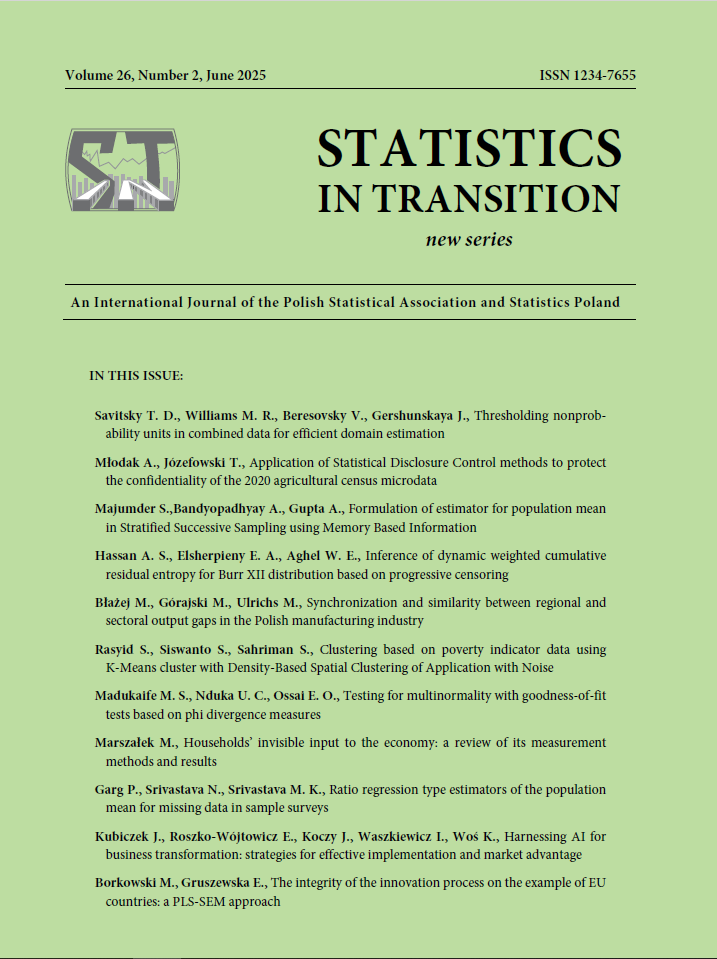ARTICLE
ABSTRACT
In study described in this article, we developed a memory type estimator for the population mean in stratified successive sampling. We used the past sample information together with the current sample information through hybrid exponentially weighted moving averages statistics. We have also used the information available on auxiliary variable to construct the proposed estimator. We studied the properties of the proposed estimator. Further, we examined the performance of the proposed estimator in comparison with conventional estimator of the population mean and the results are demonstrated by using the data set of simulation as well as natural population. After observing the auspicious findings, we suggest that the proposed estimator can be applied to solve real-life problems.
KEYWORDS
successive sampling, HEWMA, regression estimator, variance, minimum variance, efficiency.
REFERENCES
Aslam, I., Noor-ul-Amin, M., Yasmeen, U. and Hanif, M., (2020). Memory type ratio and product estimators in stratified sampling. Journal of Reliability and Statistical Studies, 13(1), pp. 1–20.
Aslam, I., Noor-ul-Amin, M., Hanif, M. and Sharma, P., (2023). Memory type ratio and product estimators under ranked-based sampling schemes. Communications in Statistics-Theory and Methods, 1–23. Communications in Statistics - Theory and Methods, 52, pp. 1–23.
Bhushan, S.; Kumar, A., Al-Omari, A. I. and Alomani, G. A., (2023). Mean Estimation for Time-Based Surveys Using Memory-Type Logarithmic Estimators. Mathematics, 1(9), pp. 21–25. https://doi.org/10.3390/math11092125.
Biradar, R. S., Singh, H. P., (2001). Successive sampling using auxiliary information on both occasions. Calcutta Statistical Association Bulletin, 51, pp. 243–251.
Chaturvedi, D. K., Tripathi, T. P., (1983). Estimation of population ratio on two occasions using multivariate auxiliary information. Journal of Indian Statistical Association, 21, pp. 113–120.
Das, A. K., (1982). Estimation of population ratio on two occasions. Journal of the Indian Society of Agricultural Statistics, 34, pp. 1–9.
Feng, S., Zou, G., (1997). Sample rotation method with auxiliary variable. Communications in Statistics-Theory and Methods, 26, 6, pp. 1497–1509.
Haq, A., (2013). A new hybrid exponentially weighted moving average control chart for monitoring process mean. Quality and Reliability Engineering International, 29(7), pp. 1015–1025.
Haq, A., (2016). A new hybrid exponentially weighted moving average control chart for monitoring process mean Discussion. Quality and Reliability Engineering International, 33(7), pp. 629–1631.
Jessen, R. J., (1942). Statistical Investigation of a Sample Survey for obtaining farm facts. Iowa Agricultural Experiment Station Research Bulletin, No. 304, Ames, Iowa, USA, pp. 1–104.
Kiregyera, B., (1984). Regression-type estimators using two auxiliary variables and the model of double sampling from finite populations. Metrika, 31, pp. 215–226.
Maji, R., Singh, G. N. and Bandyopadhyay, A., (2019). Estimation of Population Mean in Presence of Random Non-Response in Two-Stage Cluster Sampling. Communications in Statistics - Theory and Methods, 48 (14), pp. 3586–3608.
Noor-ul-Amin, M., (2020) Memory type ratio and product estimators for population mean for time-based surveys. Journal of Statistical Computation and Simulation, 90(17), pp. 3080–3092.
Noor-ul-Amin, M., (2021). Memory type estimators of population mean using exponentially weighted moving averages for time scaled surveys. Communications in Statistics-Theory and Methods, 50(12), pp. 2747–2758.
Patterson, H. D., (1950). Sampling on successive occasions with partial replacement of units. Journal of the Royal Statistical Society, 12, pp. 241–255.
Rao, J. N. K., Graham, J. E., (1964). Rotation design for sampling on repeated occasions. Journal of the American Statistical Association, 59, pp. 492–509.
Roberts, S., (1959). Control chart tests based on geometric moving averages. Technometrics, 1(3), pp. 239-250.
Sen, A. R., (1971). Successive sampling with two auxiliary variables. Sankhya, 33, Series B, pp. 371–378.
Sen, A. R., (1972). Successive sampling with p (p ?1) auxiliary variables. Annals Mathematical Statistics, 43, pp. 2031–2034.
Sen, A. R., (1973). Theory and application of sampling on repeated occasions with several auxiliary variables. Biometrics, 29, pp. 381–385.
Singh, G. N., Singh, V. K., (2001). On the use of auxiliary information in successive sampling. Journal of the Indian Society of Agricultural Statistics, 54(1), pp. 1–12.
Singh, G. N., (2003). Estimation of population mean using auxiliary information on recent occasion in h-occasion successive sampling. Statistics in Transition, pp. 523- 532.
Singh, S., Deo, B., (2003). Imputation by power transformation. Statistical Papers, 4, pp. 555–579.
Singh, G. N., Karna, J. P., (2009). Estimation of population mean on current occasion in two-occasion successive sampling. Metron - International Journal of Statistics, vol. LXVII, no. 1, pp. 87–103.
Singh, H. P., Vishwakarma, G. K., (2009). A general procedure for estimating population mean in successive sampling. Communications in Statistics-Theory and Methods, 38(2), pp. 293–308.
Singh, H. P., Tailor, R., Singh, S. and Kim, J. M., (2011). Estimation of population variance in successive sampling. Quality and Quantity, 45, pp. 477–494.
Singh, G. N., Sharma, A. K. and Bandyopadhyay, A., (2017). Effectual Variance Estimation Strategy in Two Occasions Successive Sampling in Presence of Random Non-Response. Communications in Statistics-Theory and Methods, 46(14), pp. 7201–7224.
